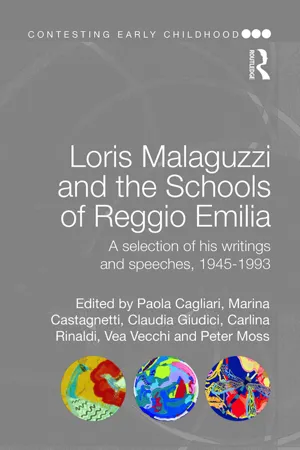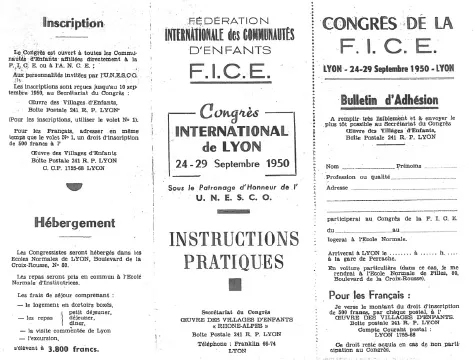![]()
Chapter 1
Early years
To 1963
Introduction (Peter Moss)
The historical context
Reggio Emilia, the city Malaguzzi was associated with for most of his adult life, is 70 kilometres to the west of Bologna and situated towards the southern edge of the Po Valley, near the foothills of the Apennine Mountains. Formerly part of the Duchy of Estense, its citizens voted overwhelmingly to join the new Italian state in 1860, when the city’s population was some 47,000. In the same year, a charity opened the city’s first asilo d’infanzia [school for 3- to 6-year-olds], offering free attendance and intended mainly for children living in poor conditions. In 1899, the socialists gained control of the comune, and remained in power for most of the time until the comune was suppressed in 1926 and replaced by a Podestà, an official appointed by the national government. From 1922 to 1943 that government was led by Benito Mussolini, whose fascist regime bequeathed the world the term totalitarismo – totalitarian.1
Before its eventual suppression by Mussolini’s totalitarian regime, Reggio Emilia’s socialist administration took a strong lead in developing education, broadly defined. Primary schooling was extended, colonie [summer camps] and music schools were established and, in 1913, a municipal asilo d’infanzia was opened in the village of Villa Gaida, serving a community with many employed mothers, but combining care with a strong commitment to progressive and secular education, working with the pedagogical ideas of Friedrich Fröbel and Ferrante Aporti. The asilo was eventually closed down in 1938 by the Podestà, who dismissed it in the following words: ‘The municipal Asilo of Villa Gaida was opened by a Socialist administration in 1912 as an alternative to the parish [Church] Asilo in existence since 1910. In a fascist regime this is not thinkable.’ Under fascist rule, therefore, Reggio Emilia was reduced to funding private asilo schools, including fourteen Catholic and three charitable institutions.
Italy entered the Second World War in 1940 and surrendered to the Allies in 1943, triggering a German occupation of Northern Italy. A resistance movement organised and grew, fighting and violence spread; Reggio Emilia, like other cities in occupied Italy, was bombed, the Malaguzzi family house reduced to ruins. These were very hard times, both for those actively involved in the resistance (with 35,000 killed in occupied Italy and many others injured or deported) and the rest of the population struggling to survive amid severe shortages, the inhuman behaviour of a repressive regime and the destruction and violence of war. Like much of Northern Italy, Reggio Emilia was only liberated near the very end of the war in Europe, in April 1945.
The immediate post-war years were also hard, with a population confronting the legacy of dictatorship and war. But despite the many difficulties, these were also years of cultural and political renewal, in Reggio Emilia but elsewhere too across Italy. The values of the anti-fascist resistance persisted: solidarity, social justice, peace, democracy. There was a great flourishing of civic society, with a wide variety of political and cultural groups forming, new meeting places emerging and many activities being revived after years of restrictions and censorship, including Malaguzzi’s beloved theatre.
Out of the resistance, strong women’s organisations emerged. The Unione Donne Italiane or UDI [Italian Women’s Union] was founded in 1944, an anti-fascist group with its roots in the Resistance movement, committed to women’s emancipation and employment and to the rights of women and children; while the Centro Italiano Femminile or CIF [Italian Women’s Centre], associated with the Catholic Action movement, was founded in 1945 and sought to promote women’s participation in society. Many future female administrators in Reggio Emilia and beyond, who were to play an important role in promoting public schools for young children, were members of the UDI.
Party politically, the national government in Rome was led for many years after the war by the Democrazia Cristiana or DC [Christian Democrat Party], a Roman Catholic and centrist party that played a dominant role in the politics of Italy for fifty years from its inception in 1944 until its demise in 1994. The second party in size for much of this period was the Partito Comunista Italiano or PCI [Italian Communist Party], which gained 23 per cent of the vote in the 1953 election (compared to 40 per cent for the DC) and continued to increase its share of the national vote until peaking at 34 per cent in 1976, close to the DC’s 39 per cent. Under its first post-war leader, Palmiro Togliatti, the PCI adopted a strategy of reform not revolution, building social and political alliances (with, for example, the DC and the middle classes) and ‘transforming the Communists from a small vanguard group into a mass party in civil society’ (Ginsborg, 1990, p.46).
Whilst lagging behind the DC nationally, the PCI was dominant in some areas of Italy and especially in Emilia-Romagna – the region in which Reggio Emilia is situated. Paul Ginsborg, the historian of post-war Italy, writes that ‘the Communists reigned supreme [in Emilia-Romagna] from the end of the war onwards . . . [affording] the PCI a quite extraordinary degree of support when compared with the rest of the country’ (ibid., p.200); by 1947, the PCI had a membership of nearly half a million people in the region, almost a fifth of the adult population. Space precludes exploring the reasons for this dominance. However two aspects merit attention here. First, it was not based on heavy industry and its proletarian workforce; Emilia-Romagna, after the war, was an area of small businesses, artisans and farm workers. The PCI made alliances with and drew support from all of these sectors, adopting an inclusive strategy. Second, the Party strove to win control of local authorities and demonstrate its capacity to govern well; Bologna, the region’s largest city, became the showpiece of Communist local government, and the city’s ‘efficiency and honesty contrasted favourably with the chaos and corruption in many other areas of Italy’ (ibid., p.203). Such local efficiency and honesty was in marked contrast, too, to the inertia and failure to bring about change that marked central government under DC leadership and its unreformed bureaucracy.
The post-war years, and especially from the late 1950s, was a period of economic and material development, culminating in Italy’s so-called ‘economic miracle’. In the twenty years from 1950 to 1970, per capita income grew more rapidly than in any other European country. And with economic growth and fast rising household incomes came consumerism, urged on by an unprecedented expansion of advertising. Television ownership rose from just 12 per cent of families in 1958 to 49 per cent in 1965, fridge ownership from 13 to 55 per cent, while the number of cars soared from 342,000 in 1950 to 4.67 million in 1964 (ibid., p.239).
With economic and material growth came three demographic and social changes. There was massive migration, from countryside to town and from South to North; between 1955 and 1971, more than nine million Italians moved from one region to another. This in turn contributed to a decline in the strong linguistic hold of local dialect, as people from different parts of Italy increasingly mixed and under the centralising influences of TV and school, with the children of migrant families often turning up at new schools initially understanding little that was said to them. Finally, migration, urbanisation, economic growth and consumerism produced a growing atomisation of civil society with an accompanying isolation of families. The nuclear family was becoming more important than ever, but also increasingly solitary; and while ‘this privatization in smaller family units’ may have had some good points, it also meant that ‘each nuclear family unit tended to be more closed in upon itself, and less open to community life or to forms of inter-family solidarity’ (ibid., p.243).
It is against this historical backdrop that we can view the evolution of post-war early childhood education in Reggio Emilia. After the war, Reggio Emilia regained its democratic local government, with successive Socialist-Communist administrations. As the texts reproduced below illustrate, the revived Comune became active in many areas, providing a range of services for children and young people, such as colonie and a centre for children with mental health problems, services combining medical, psychological and pedagogical functions. It also took seriously its cultural role, supporting theatre, cinema and music, and widening popular participation by attracting new audiences, for example by a policy of low-price tickets.
But until the late 1950s, the Comune was slow to give strong support to the needs of women and young children. Early initiatives were taken by private organisations. For example, in the immediate post-war years the UDI opened eight self-managed asili for 3- to 6-year-olds within the city boundaries; one of these, the asilo del Popolo [school of the people] that opened in 1947 in the nearby village of Villa Cella, would come to play an important part in Malaguzzi’s life. The UDI and (with a minor role) the CIF also initiated other projects for women and children in and around the city in the 1950s, including temporary asili set up during harvest time, after-school centres and summer camps.
The Comune faced external constraints in developing its own services. Despite the restoration of local democracy, central government continued to exert strong control over local affairs, through the powers exercised by the Prefetto [Prefect],2 limiting spending on early childhood services by classifying them as ‘optional’, and strongly urging that these services be mainly Church run. By 1962, the seven remaining asili run in Reggio Emilia by the UDI were far outnumbered by the twenty-two Catholic scuole materne.3 Local initiatives were also constrained by the Opera Nazionale Maternità e Infanzia or ONMI [Organisation for Maternity and Childhood], a national organisation inherited from the fascist regime that continued to be the main agency of the State for the health and welfare of young children and mothers, and which opposed the provision of municipal nurseries.
But as Italy’s ‘economic miracle’ gathered momentum and under sustained pressure from the UDI and other organisations demanding the establishment of municipal schools for young children, the Comune began to seek ways to establish these services – despite the obstacles placed in its way by the government in Rome. The breakthrough came in 1962. The council that year debated women’s employment and the provision of public services. Christian Democrats argued for a strategy of part-time employment for mothers, while the UDI and left-wing politicians called for early childhood services. Under the newly elected Mayor Renzo Bonazzi, who was an ardent supporter of Reggio Emilia’s educational project during the fifteen years he held office, the Comune decided on the latter course and the first municipal school for 3- to 6-year-olds was agreed: Robinson Crusoe opened on 5 November 1963, housed in a prefabricated building to get around the obstructive regulations of the Prefect.
Reggio Emilia’s project of early childhood education had begun. It was an important moment: the local community assuming responsibility for the education of its young children, and also challenging the dominant position of the Catholic Church in this field. In a much later interview, Malaguzzi emphasised that the establishment of Robinson Crusoe school marked ‘a rightful and necessary break in the monopoly the Catholic Church had hitherto exercised over children’s early education . . . [citizens and families] wanted schools of a new kind: of better quality, free from charitable tendencies, not merely custodial, and not discriminatory in any way’ (Malaguzzi, 2012, pp.31–2).
Malaguzzi’s life
It was during these years – by turn repressive and libera...



